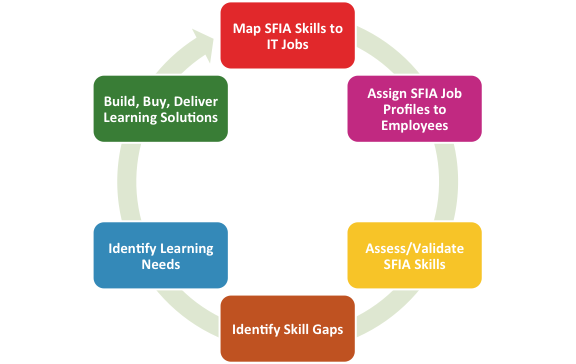(SFIA: Skills Framework for the Information Age)
How does your organisation determine the learning needs of its IT employees? For many organisations it works like this; once a year, at some point prior to preparing the training budget, a catalogue of learning solution is distributed and managers and/or employees will have the option of selecting which solutions are required and, in the case of departmental managers, how many are required. The learning solution catalogue is often based on training that was delivered last year, the training vendor’s current catalogue and hopefully input from technical specialists within the organisation.
What if last year’s offerings are out of date? What if your managers haven’t properly checked on their team’s requirements? What if your training vendor is driven to promote their courses without understanding your needs? What if your managers’ and employees’ selections aren’t based on actual business needs? What if…?
In some cases the approach is even more random.
Isn’t there a more accurate and objective way of identifying your organisation’s IT learning needs? Yes, there is and the answer comes in the form of SFIA-based job roles.
By mapping SFIA skills and levels to your IT jobs and then having your employees assess their SFIA skills it is possible to identify where your employees greatest skill gaps are. If you have done the job of mapping skills to jobs accurately and in line with your business requirements, the gaps will indicate which skills require development in order to support business need rather than any other agenda. Furthermore, by mapping learning solutions to skill gaps you will be able to determine which learning solutions you will need to deliver in order to address your IT business needs. This methodology is graphically represented below:

What happens if you don’t have a learning solution in place to address a gap? This approach also provides you with a clear view of which learning solutions you need to develop or procure. Rather than taking a speculative approach to developing, procuring and delivering your learning solutions, a SFIA-based methodology will enable you to make the best use of your hard-earned learning budget.
There are many other advantages to this approach too, not least being the ability to develop a SFIA skills profile and learning plan for each employee and the ability to aggregate and determine needs for teams, countries and regions. It also provides the ability to plan the most effective use of learning resources and allow you to determine if you should build or buy, and whether you should choose onsite or public courses.
So here are another couple of questions that often crop up:
a) Isn’t it a lot of work to map training solutions to the skills in SFIA?
b) How can we use SFIA to determine the content that we need to source and/or develop?
The answer to a) is yes, it can be, however many training vendors have already done the work of mapping their training catalogues to SFIA skills. It is in the interest of training providers to do this work and share it with you as this approach will also help them to provide you with appropriate solutions. If you use an external training provider check whether they have already done this work for you, if not, then you may need to do this work yourselves, perhaps facilitated by your Learning and Development team. This will ensure that your learning solutions are up-to-date, fit for purpose and that you are making the most of your training budget.
The answer to b) is that the skills in the SFIA framework provide a great deal of detail which you can leverage, for instance the SFIA skill descriptors and proficiency indicators can be used to outline the learning outcomes of any learning solutions that you have identified for development.
Learning and Development resources and budget for IT are precious; make sure that you make the optimum use of them by taking a more scientific approach to identifying your learning needs and by leveraging the power of SFIA!



